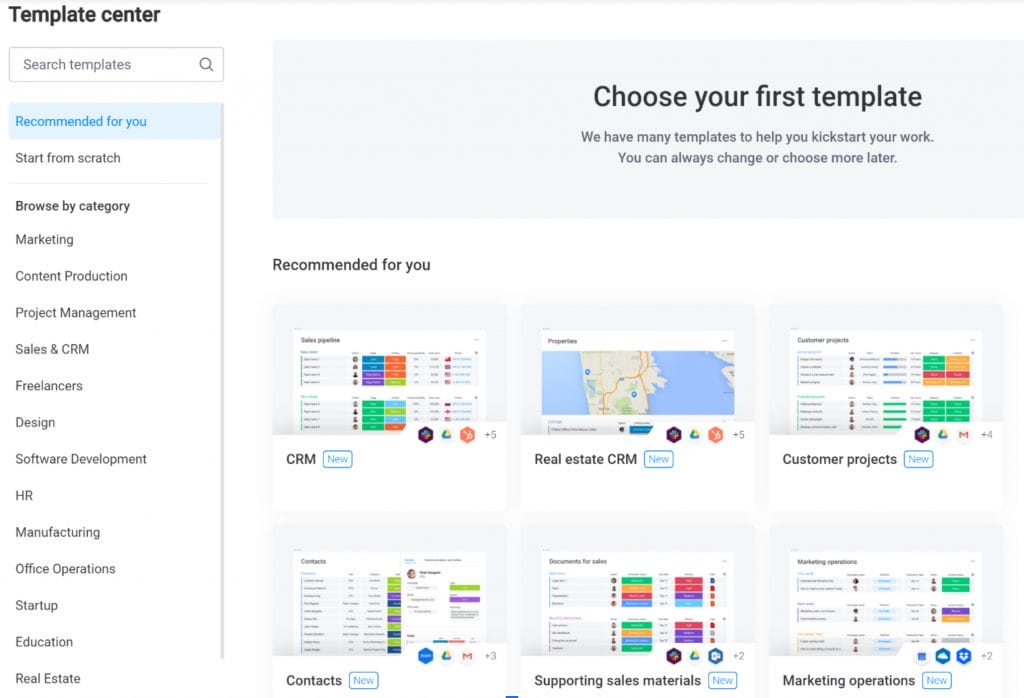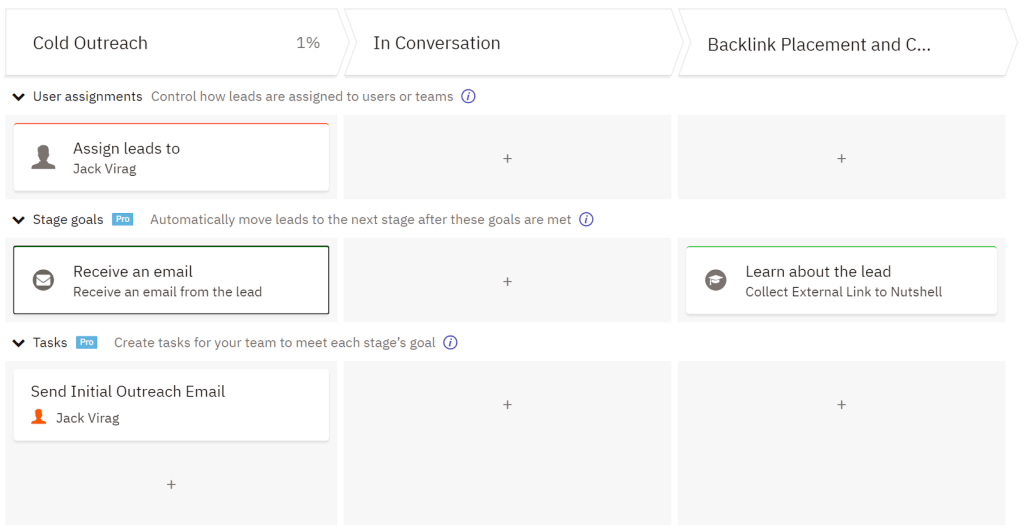
Any mad scientist can tie some spreadsheets together and advertise it as a CRM, so in true investigative fashion a few things will need to be established before determining whether or not Monday CRM is legit:
For the sake of fairness, we’ll be using our own product, Nutshell, as a reference.
A CRM, or Customer Relationship Management tool, is any software that is designed to reduce manual labor and streamline sales processes. CRMs differ from project management tools because they are specifically catered towards sales, marketing, and customer support, whereas project management tools are centered around projects and timelines.
From a technical perspective the platforms might seem similar. At their bottom layer, they are both databases, which are then wrapped in neat user interfaces.
You can think of the data behind a CRM being based around people, companies, and leads, and the data behind a project management tool to be projects, budgets, and teams.
One layer up from the data is where “the magic happens.” CRMs and project management software handle the data fundamentally differently, because they’re designed to do different things. The logic and framework behind these layers are like night and day. A person or company added to a CRM is automatically attached to different formulas, equations, data, syntax, workflows, etc., than a person or company added to a project management suite.
Essentially, CRMs and project management software both consist of databases displayed on user interfaces, but what happens between those two layers is completely different.

CRMs are designed to help teams:
Project management software, on the other hand, is designed to help with:
Now for the good part: What does Monday feel like in its brand new CRM mode?
Monday’s new CRM looks very cool. Upon signing up, users are introduced to a squeaky-clean user interface full of dashboards and different ways of viewing and assembling data.
The colors are refreshing, but also contextually appropriate. A little green “progress” bar appears next to each lead, signifying its progress through the sales pipeline.
But how useful is it as a CRM? Certain features, like being able to manually enter a lead’s priority level, sound like real things that salespeople might say. But what a salesperson would need, and what a CRM would deliver, is the ability to have the pipelines themselves represent a lead’s priority and handle them accordingly.
Because it’s not just a user-entered attribute to filter by, but an actual function behind an actual sales process.
When registering for Monday, users are required to choose a “template” for their Monday.com experience, and the CRM is literally just one of those templates.
After using it for a while, it becomes clear that Monday’s CRM is exactly that: a different visual template for portraying the same data from a typical Monday project management-style experience.

But the realization that Monday CRM is just regular Monday project management software “in disguise” isn’t immediate, and only becomes apparent after actually trying to use the software. Almost all of its functionality is derived from its original project management capabilities.
Dashboards, customization, and visualization are everywhere. The CRM resource center, for instance, is a help center visual board full of content, videos, and bulleted lists, and is actually created using the Monday platform itself.
Each to-do item on the dashboard is a custom widget that can be interacted with, and deleted when done, demonstrating Monday’s powerful project management features while simultaneously training users how to use the product.
But when registering for the CRM template, users are advised “you can always change templates later,” as an afterthought. But a CRM isn’t an afterthought that users can change later. And any experience using CRMs that were designed specifically for salespeople makes this statement an alarming one.

Monday’s CRM template is focused on managing from three different perspectives: Contacts, which is the data layer, Sales Pipeline, which is the visual layer, and the Sales Dashboard, which is a reporting hub.
Nutshell Pro automates the tasks that slow you down.

The “contacts board” is an area where users manage their contacts and the data associated with them. This data ultimately feeds into the sales pipeline view.
Essentially, the contacts board is the heart of Monday’s self-titled CRM, whereas powerful CRMs like Nutshell are three-hearted Cerberuses, pulling their data from people, companies, and leads repositories which each serve different useful functions.
Monday CRM has just one heart, the contacts board, and its features are still conspicuously reminiscent of a project management tool.
The contact board’s lack of CRM functionality becomes obvious quickly. “People” data, rather than having its own unique interface, is displayed on a project management-style “item card.”
On the item card itself, there are multiple tabs that must be toggled through to view the activity log, updates, sales activities, and email activities—all things that most CRMs would just consolidate onto the “people” interface.
Furthermore, updates to this page are manual and don’t inherently pull data from elsewhere, unlike purpose-built CRMs. And the fields for “comments” and “notes” are redundant and basically exist to remind users of a feature that a real CRM would actually have.
The lack of CRM functionality is horrifically obvious when users click on a person’s “company:”

It’s just a text field, without links or data from other sources, and can be changed on the fly. Very superficial, almost entirely useless, but to Monday’s credit it still kind of looks like a CRM.
In essence, the contacts view is centered around the person data, and its sole value comes from the arbitrary fields that can theoretically be tied together on the back-end, like some kind of strange build-your-own-CRM. But you do have to build it yourself.
Monday’s CRM sales pipeline is a different visualization for the same data as the contacts board, plus the ability to create a new field, “Deals,” and manually assign them a stage.

In Nutshell, for instance, users would be able to click on a lead and see the entire activity timeline for that lead, including interactions the prospect has had with other sales reps, which emails they’ve opened, etc.
Furthermore, pipelines in Nutshell are set up with sales and marketing-based logic so that users can intuitively define what actions move the prospect from one pipeline stage to the next, like having leads move from the “outreach” stage to the “conversation” stage when they reply to an email.

However, on Monday’s sales pipeline board, clicking on a deal brings up another project management-style item card with a few widgets displaying the data about the deal, including the contact info and deal-specific information.
There’s also the “priority” field for each deal, which demonstrates just how shallow Monday’s CRM functions truly are: Again, in a properly-configured CRM, deals with a higher priority would be handled by a higher-priority pipeline that gives prospects a different treatment, rather than just being slapped with a UI sticker that says “high priority.”
(Missing) CRM functionality aside, the sales dashboard is brilliant and fun. It’s a project management board composed of customizable widgets designed to help users better understand the data within their platform.

Widgets can be rich text, infographics, charts, graphs, formulas (like forecasted revenue), videos, and more.
In the sales dashboard, these widgets come pre-configured to not only illustrate the various goings-on within the CRM platform, but also to inform the users on how to use the CRM, and even the sales dashboard itself.

Monday’s pricing tiers are as follows:
* Monday’s plans all require three users at minimum, so the Standard version’s minimum price comes out to $30/month.
The issue is that, unless a sales team is hardly using the CRM, they’ll probably need the Pro version, as the Standard version only allows for 250 automation actions* per month.
*Automation actions are described as the action that occurs any time an automation or integration performs the action it was set up to do, like sending one notification.
For teams of three or more users, Monday is still cheaper than Nutshell’s CRM, whose prices are:
* Nutshell’s plans do not require a minimum number of users.
But is Monday CRM’s lower price tag worth it?
A pricing comparison between Nutshell and Monday is practically meaningless since the platforms are so different.
Nutshell, from the ground up, was designed as a CRM that automates the work of sales teams. Monday, despite having a CRM template, is still a project management tool with a few CRM-related fields and visualizations added.
But how does Monday compare against other project management tools, like Trello, for instance?
Against Trello, Monday doesn’t seem to understand where they fit either. Where Trello’s $10/user/month plan is straightforwardly priced, Monday’s pricing model still has that 3 users or more caveat, bringing the cost up to $30 a month.
And Trello’s plan allows for (up to) 6,000 automations per month, compared against Monday’s 250. 😬
Monday’s project management platform is great for project management, but that’s it. The same way re-tuning a banjo doesn’t turn it into a guitar, there is no template or UI re-skin that can turn Monday into an actual CRM. They are entirely different platforms behind the scenes.
It’s worth noting that all CRMs are different, and each comes with its own perks. When choosing which CRM is right for your team, it’s extremely important to:
It’s easy to slam Monday for feeling half-baked, but its CRM truly is still fresh out of the oven. The company itself was recently valued at $1.9 billion, and its project management suite might actually be the best one on the market.
Email platforms are becoming CRMs, landing page builders are becoming CRMs, it makes sense that Monday would launch its own CRM too, especially after such a large round of fundraising. The valuation might even be contingent on Monday securing users from other markets like sales and marketing.
So the CRM is still just a UI template for now, but who’s to say what it’ll look like in a couple of Mondays?
No problem. To see if Nutshell is the right choice for your sales team, start a 14-day free trial today!

Join 30,000+ other sales and marketing professionals. Subscribe to our Sell to Win newsletter!